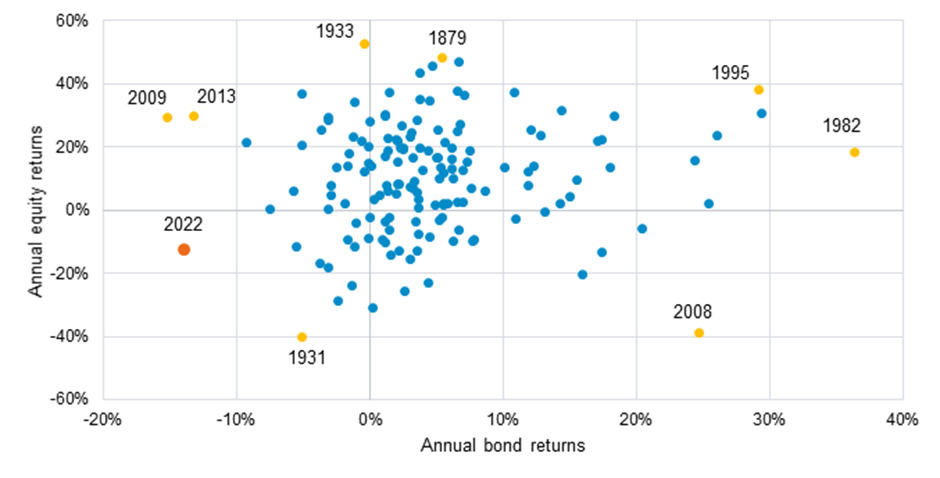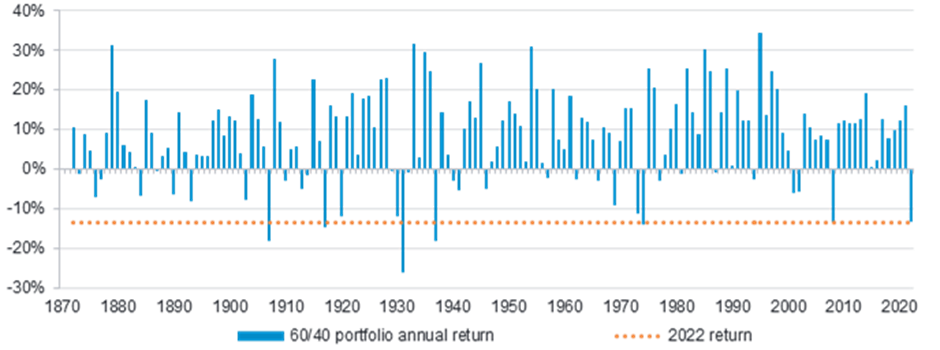Annual nominal returns of S&P 500 and US 10y Treasuries 1870-2022; data for 2022 is year to 01/12/22. Source: pre-2021 data from Òscar Jordà, Katharina Knoll, Dmitry Kuvshinov, Moritz Schularick, and Alan M. Taylor. 2019. “The Rate of Return on Everything, 1870–2015.” Quarterly Journal of Economics, 134(3), 1225-1298, post-2020 data from Refinitiv, Fidelity International, December 2022.
What will 2022 be remembered for? The beginning (and it is disheartening to have to add that qualifier) of the Ukraine war will rightly be the first entry under 2022 when the history books are written. But for markets, the US Federal Reserve (Fed) was the only game in town.
Runaway inflation and major central banks’ aggressive monetary tightening, spearheaded by the Fed, dominated the market narrative for the year. The rapid rise in yields drove bonds to one of their worst ever years and caused longer-duration equity multiples to plummet. Slowing growth and tighter financial conditions weighed on equities more generally.
While not quite unique, the negative performance of both equities and bonds makes 2022 highly unusual, as the chart above shows. The chart below, meanwhile, reveals that there have only been a handful of times that a 60/40 portfolio of US assets has performed worse in the last 150 years.
Top Australian Brokers
- Pepperstone - Trading education - Read our review
- IC Markets - Experienced and highly regulated - Read our review
- eToro - Social and copy trading platform - Read our review
So, what can we expect in 2023?
A potential recession, among other challenges, which is why we are still defensively positioned overall. However, we do not expect bonds to perform so poorly or to be as positively correlated to equities next year, and we have recently moved overweight government bonds.
Forecasting is a difficult business. Financial history, indeed, all of history, is littered with bombastic claims about the significance of recent events that are exposed as naïve or foolish with the benefit of hindsight. However, even with this in mind, we believe 2022 may mark a significant shift in how a generation of investors, policy makers and consumers will think about inflation and interest rates. Not only does it appear that the post-financial crisis era of cheap money and quantitative easing is definitively over, but also the era of low inflation and ever-decreasing rates that investors had grown accustomed to since the early 1980s. We continue to analyse the investment implications of this regime shift, both from a tactical perspective as well as in the medium and longer term.
No room to hide: 2022 was among the worst for a US 60/40 portfolio in the last 150 years
Annual nominal return of 60/40 portfolio of S&P 500 and US 10y Treasuries, 1870-2022; data for 2022 is year to 01/12/22. Source: pre-2021 data from Òscar Jordà, Katharina Knoll, Dmitry Kuvshinov, Moritz Schularick, and Alan M. Taylor. 2019. “The Rate of Return on Everything, 1870–2015.” Quarterly Journal of Economics, 134(3), 1225-1298, post-2020 data from Refinitiv, Fidelity International, December 2022.
Originally published by Fidelity







